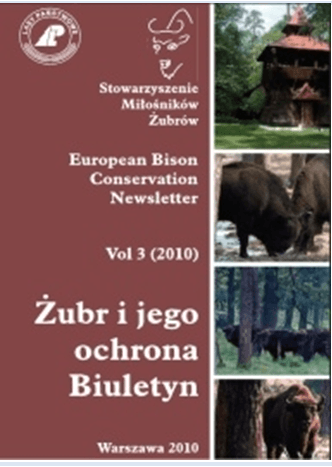Management of wisent population in the Bieszczady Mountains
Keywords:
Bison bonasus, Bieszczady Mountains, management, Carpathian metapopulationAbstract
On October 30, 1963 the wisent came back into the Polish Bieszczady Mountains and presently population of size 300 heads is divided into two sub-populations: the eastern and the western one. For almost 50 years the foresters from the area managed by Regional Administration of State Forests in Krosno have been responsible for protection of the Bieszczady wisents. Their activities comprise the following areas: veterinary protection, feeding in winter, monitoring, preventing from temporary or permanent threats as well as searching for possibilities of increasing the size of the wisent population in the Bieszczady Mountains. Until 1999 the forester’s conservation activities were financed from the Forest District Offices’ own means. Since 2000 Regional Administration of State Forests in Krosno has been putting forward motions of different projects financed from National Environment Protection Fund or World’s Environment Protection Fund. One of the most important tasks of wisent population management is thorough identification of its parameters. This task is being carried out as part of the project Permanent Wisent Monitoring in the Area of the Bieszczady Forest District Offices, the execution of which has been commissioned to Carpathian Research Station Wildlife at Ustrzyki Dolne. The important part of monitoring is determining and updating the wisent refuges in the area of the Bieszczady Mountains, monitoring of these refuges as well as indicating the most important migration corridors. Despite immense efforts of foresters, scholars and enthusiasts, the Bieszczady wisents struggle with numerous problems, such as illnesses (tuberculosis), low genetic variability, poaching, and lack of cooperation with Ukraine and Slovakia in the field of breeding and protection of wisents in the border areas. The biggest threat for the Bieszczady wisents is tuberculosis, but monitoring of wisent population in the Bieszczady is not sufficient in this respect. With the aim of reducing the level of parasites in wisents, the collection of excrement samples is being done regularly as well as
annual action of treatment anti-worms in these animals. Another serious problem of Bieszczady wisent population is very low genetic variability. In order to increase it the systematic supplying the local population with the genetically selected specimens from the captivity is carried out. Important threat is also poaching, mainly in the borderland with Ukraine. The most significant tasks that the Regional Administration of State Forests in Krosno is currently facing are (1) establishing cooperation with Ukraine and Slovakia as part of joint Carpathian wisent metapopulation; (2) systematic monitoring of health; (3) preventing wisents from poaching, particularly in the border zone.
Downloads
Published
How to Cite
License
Copyright (c) 2010 Piotr Brewczyński

This work is licensed under a Creative Commons Attribution 4.0 International License.





